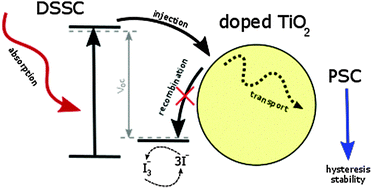Doping of TiO2 for sensitized solar cells
Abstract
This review gives a detailed summary and evaluation of the use of TiO2 doping to improve the performance of dye sensitized solar cells. Doping has a major effect on the band structure and trap states of TiO2, which in turn affect important properties such as the conduction band energy, charge transport, recombination and collection. The defect states of TiO2 are highly dependent on the synthesis method and thus the effect of doping may vary for different synthesis techniques, making it difficult to compare the suitability of different dopants. High-throughput methods may be employed to achieve a rough prediction on the suitability of dopants for a specific synthesis method. It was however found that nearly every employed dopant can be used to increase device performance, indicating that the improvement is not so much caused by the dopant itself, as by the defects it eliminates from TiO2. Furthermore, with the field shifting from dye sensitized solar cells to perovskite solar cells, the role doping can play to further advance this emerging field is also discussed.



 Please wait while we load your content...
Please wait while we load your content...